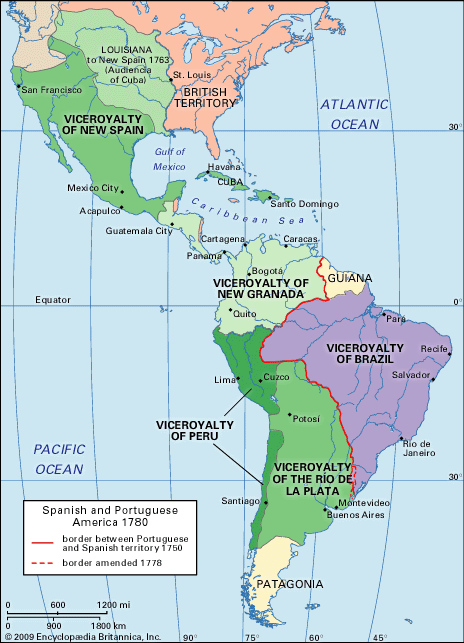The first Macombers in America were an integral part of the era called Modern Colonialism. “The age of modern colonialism began about 1500, following the European discoveries of a sea route around Africa's southern coast (1488) and of America (1492). With these events sea power shifted from the Mediterranean to the Atlantic and to the emerging nation-states of Portugal, Spain, the Dutch Republic, France, and England. By discovery, conquest, and settlement, these nations expanded and colonized throughout the world, spreading European institutions and culture” (Western Colonialism, 2010).
 |
| British, Portugues and Spanish America circa 1780 |
Colonial American MACOMBERs are primarily descended from three European peoples: Celtic, Germanic, and Scandinavian as explained in the paragraphs below. The modern distribution of European cultures and peoples depicted in the map presented below is a culmination of past geographic and cultural events. For example, the English culture depicted on the map below is the result of 1) Germanic people (see map) invading and inhabiting eastern portions of the British Isles starting in the A.D. 400s and pushing the Celtic people (see map) into western regions, 2) Scandinavian people (see map) invading eastern Britain starting in the A.D. 800s, and 3) the subsequent commingling of the Scandinavian, Germanic, and Celtic peoples and cultures.
 |
| Map of the Peoples of |
Western Europe collapsed into major disarray with the decline of the Roman Empire and the demise of a strong, central government (see end note 1 at bottom). During the A.D. 300s, Roman legions vacated what was called Britain to defend other regions of the Roman Empire against various peoples. Subsequently, during the 400s and beyond, Angles, Saxons and Jutes, which were Germanic people from Europe, increasingly invaded the central, fertile valleys of Britain and pushed the native Britons, or Celts, into the less fertile hills of Scotland, Ireland, Wales, and the southwestern peninsula of Britain where remnants of Celtic languages and culture survive to this day (see the map below).
 |
| Remains of a Roman Road |
The Celts tended to be shorter, darker, and have more rounded heads than the invading Germanic peoples who tended to be taller, blonde, and blue-eyed; though some Celts had red hair and ruddy complexions.
Later, during the 800s, a large number of Vikings from Scandinavia raided and settled in Britain, which contributed to Britain being divided into small kingdoms ruled by either Scandinavian tribal chiefs or local Anglo-Saxon leaders. Consequently, most commerce between the British Isles and other parts of the world ceased, and most people were forced to make a living from off the land rather than from former trades that were prevalent within the Roman Empire . Thus began a new era called the Dark Ages, the Middle Ages, or Medieval Times, which began with the fall of the Roman Empire sometime around A.D. 500 and continued until the mid-1400s.
_________________________________Western Colonialsim. (2010). In Encyclopædia Britannica. Retrieved April 10, 2010, from Encyclopædia Britannica Online: http://www.britannica.com/EBchecked/topic/126237/colonialism
End Notes
1. By making this comment, I am not endorsing a political system with a strong central government like that of theRoman Empire . History demonstrates that strong central governments tend to transfer power and wealth from the general populace to a select few and inhibit individual freedoms, which in turn impedes innovation and stifles progress. History further confirms that the Roman Empire was better for Europeans than tribalism that followed, but not as good as a modern republic similar to the United States of America or the Federative Republic of Brazil.
1. By making this comment, I am not endorsing a political system with a strong central government like that of the
No comments:
Post a Comment